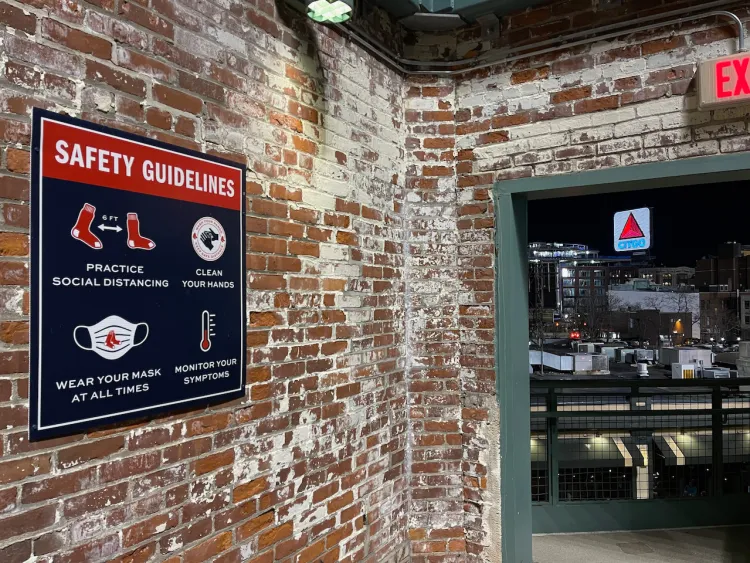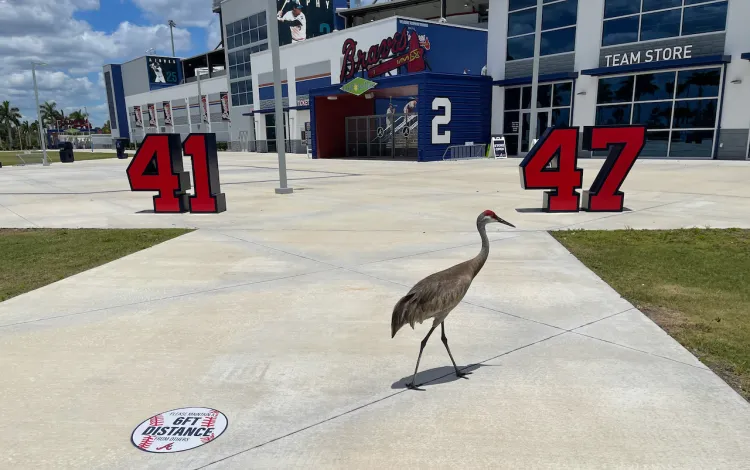
As fans started to return to stadiums, they came back to a very different environment and new rules. Even though certain states removed restrictions earlier than others, the sports leagues generally appeared to follow the same guidelines being dictated by their league offices. So while the state of Indiana generally eschewed mask requirements and social distancing norms well before my home state of Massachusetts, the requirements for attending a Fort Wayne Komets game generally were the same as those at the TD Garden for a Celtics game. It appeared that the private sector was going to move a bit more cautiously than many local governments.
L: Real fans mixed with cardboard fans at TD Ballpark in Dunedin, FL for the Toronto Blue Jays “home” games; R: Seating generally was only allowed at seats in Cleveland.
While each stadium is different, I found some consistent themes at the games I attended. The basics included:
Social Distancing – Distancing is enforced at many stadiums by restricting the number of fans in attendance based on local guidelines. As a result, tickets generally have to be purchased in “pods” of 2 or 4 seats. Some stadiums allow for groups of 1 and 3 as well, but that was not the norm. As a result, despite being solo, I had to buy 2 tickets a few times.
Limited Capacities – Also, large portions of stadiums are blocked off and not in use at this time to maintain distancing. In a few cases, I was the only person in my row at an arena. As of this writing, more and more states are opening up their stadiums to increased capacities and, thus, the pod situation should disappear soon. That said, those restrictions may remain in place a bit longer in countries outside the U.S.
L: Signage spelling out the rules in Columbus, OH; R: I had an entire row to myself at the Cleveland Cavaliers game.
The side benefits of attending nearly empty stadiums are an unexpected treat. Watching a hockey game in front of a nearly empty stadium enables the fan to listen to the near constant chatter amongst the players on the ice. Similarly, I could hear Coach Stan Van Gundy yell at his team from the opposite side of the arena. The downside is that one also can easily hear the rants of even a single drunken fan quite easily. One can only hear a sole drunk yell “SET IT UP” to the Columbus Blue Jackets’ offense so many times.
L: Pregame lineup exchanges look a bit different this year; R: Fenway Park signage.
The other benefits are a bit more obvious – easier entry and exits, limited traffic and close up parking to name a few. A downside for younger fans is that access to players is more limited and autographs and selfies are harder to obtain.
Segregated Seating – Many stadiums websites already are providing separate sections for vaccinated and unvaccinated fans. It appears that most fans will be on the honor code to sit in the proper sections. In other stadiums, there are certain sections that are “socially distant,” but those sections may not be very desirable. For example, the Texas Rangers provide socially distant seating only in the top level in the outfield of their new Globe Life Field.
Masks – Masks generally are required at stadiums even if the local regulations do not call for them. As private businesses, stadium management in the U.S. can elect to have more restrictive rules. It appears that all the stadiums are taking the cautious approach and are continuing the mask requirement for the time being. Like restaurants, masks generally are only supposed to be removed when actively eating or drinking. Some stadiums are specifically telling their fans to wear masks if they’re unvaccinated, with vaccinated people being able to enjoy the game mask free.
L: Bag restrictions are almost universally very restrictive; R: Social distancing in the bathroom of TD Ballpark in Dunedin, FL.
Digital Tickets – In most cases, fans can only enter a stadium using a digital ticket on their smart phones. The process can vary and often requires an app download in advance. Don’t forget to charge your phone in advance for both the digital ticketing and concessions purchasing.
Covid Waivers – In most top level professional venues, fans needed to complete a smart phone waiver and declaration prior to entering the stadium. These forms generally mirror the types of questions asked when entering any doctor’s office. When required, fans needed to show the ticket takers that they have been cleared for entry based on completion of the form. An email generally is sent to the fan who purchased the tickets a day or so in advance of the game. Again, it’s good to download the app in advance to avoid hassles on game day.
L: This small clear backpack technically was against the rules, but the usher at the gate was accomodating; R: PNC Park looks beautiful even with only 5,000 fans attending.
Entry restrictions are much more stringent – The stadiums are almost universally restricting bag size to something very, with the exception being for diaper bags or medical reasons. Those clear bags favored by many stadiums are often not going to be allowed for the time being. According to many teams, these restrictions are to speed up entry and limit interactions between stadium personnel and fans. Given that I always bring a camera to games, I have found this restriction to be problematic given that I now need to keep everything on my body and not even in a small bag. As has always been the case, the stadium personnel differ on how strictly they will enforce the limits. While I had multiple ticket takers strictly measure my bag and prohibit it (looking at YOU Columbus Bluejackets security), most have been accommodating after telling them that I tried hard to comply with the rules and traveled from a long distance.
Cash free – Most stadiums do not allow for cash to be used for food or merchandise. Some stadiums require food to be purchased from their stadium app prior to approaching a food stand. Again, be sure to have your phone charged.
L: Hand sanitizer is available all over the ballparks; M: A sandhill crane kept its distance at the Braves’ spring training facility Cooltoday Park in Venice, FL.; R: Coach Stan Van Gundy’s voice easily carried throughout the arena at the Pelicans vs Cavaliers game in Cleveland.
Limited food options – During the times stadiums have been at limited capacity, the food selection too has been limited. Also, I have yet to see a single stadium vendor roaming the seats with food offerings. As a result, lines tended to be longer than normal, so plan accordingly.
Non-game Entertainment – To limit social interaction, almost all non-game entertainment has been shifted to remote locations and instead is shown on the video board. So rather than witness the Pittsburgh Pirates famous pierogi race live, it occurred on the nearby Clemente Bridge and was shown on the scoreboard. Also, giveaways at the gate and American classics such as the t-shirt cannon have disappeared in this post-Covid world for now.
L: Scoreboards constantly reminded fans to wear masks; R: Pedro Martinez threw out the first pitch at Worcester’s Polar Park while wearing a mask like everyone else at the park.
Other facilities are closed – Because of covid concerns, water fountains and children’s play areas appeared to be universally closed. In general, expect a barebones experience at the stadium, with limitations big and small.
Sports bars were devasted – Sadly, many sports bars were casualties of Covid. Without fans watching live sports, these bar closed their doors and many have not reopened.
L: Most teams required a pre-screening before entry to the game on smartphones; R: Many stadiums required fans to complete a covid waiver before entering and show the check to gate employees.
Although many stadiums still are being used as mass vaccination sites, more and more sporting venues will open to the public soon. While these information in this blog should provide you a guideline on what to expect, it’s best to closely monitor each team’s website to keep up to date with the ever-changing rules. Be prepared to be flexible and accommodating, but returning to stadiums should help us all recover some semblance of normalcy.
Play Ball!!!!
L: Fewer than 1,700 fans attended the Blue Jays – Red Sox game in Dunedin at the Blue Jays home on the road; M: Liquor rules trumped mask rules at Fenway; R: Blocked off seats at the Wheeling Nailers hockey game.
L: The football marching band was not in marching mode at the Spring Green-Black Game at Marshall University; R: Indiana University’s Assembly Hall in Bloomington, IN was an observation waiting area for accination shots.
Top L: This Michigan fan couldn’t resist giving Brutus Buckeye a piece of my mind; Top R: With social distancing in effect, the Pittsburgh Pirate Pierogis were relegated to racing on the nearby Clemente Bridge; Bottom L: National Anthems often was sung from a remote location; Bottom R: The “Arsenal Bar”, Boston’s LIR on Boylston, was one of the many sports bars to suffer without fans for over a year.




























Comments